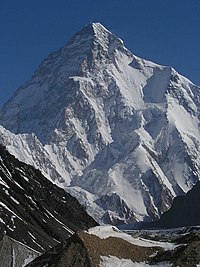
Photo from wikipedia
Geophysical granular flows, such as avalanches, debris flows, lahars and pyroclastic flows, are always strongly influenced by the basal topography that they flow over. In particular, localised bumps or obstacles… Click to show full abstract
Geophysical granular flows, such as avalanches, debris flows, lahars and pyroclastic flows, are always strongly influenced by the basal topography that they flow over. In particular, localised bumps or obstacles can generate rapid changes in the flow thickness and velocity, or shock waves, which dissipate significant amounts of energy. Understanding how a granular material is affected by the underlying topography is therefore crucial for hazard mitigation purposes, for example to improve the design of deflecting or catching dams for snow avalanches. Moreover, the interactions with solid boundaries can also have important applications in industrial processes. In this paper, small-scale experiments are performed to investigate the flow of a granular avalanche over a two-dimensional smooth symmetrical bump. The experiments show that, depending on the initial conditions, two different steady-state regimes can be observed: either the formation of a detached jet downstream of the bump, or a shock upstream of it. The transition between the two cases can be controlled by adding varying amounts of erodible particles in front of the obstacle. A depth-averaged terrain-following avalanche theory that is formulated in curvilinear coordinates is used to model the system. The results show good agreement with the experiments for both regimes. For the case of a shock, time-dependent numerical simulations of the full system show the evolution to the equilibrium state, as well as the deposition of particles upstream of the bump when the inflow ceases. The terrain-following theory is compared to a standard depth-averaged avalanche model in an aligned Cartesian coordinate system. For this very sensitive problem, it is shown that the steady-shock regime is captured significantly better by the terrain-following avalanche model, and that the standard theory is unable to predict the take-off point of the jet. To retain the practical simplicity of using Cartesian coordinates, but have the improved predictive power of the terrain-following model, a coordinate mapping is used to transform the terrain-following equations from curvilinear to Cartesian coordinates. The terrain-following model, in Cartesian coordinates, makes identical predictions to the original curvilinear formulation, but is much simpler to implement.
Journal Title: Journal of Fluid Mechanics
Year Published: 2017
Link to full text (if available)
Share on Social Media: Sign Up to like & get
recommendations!